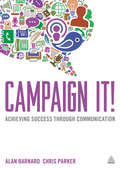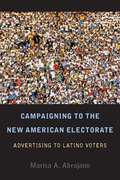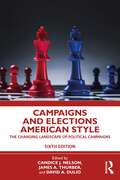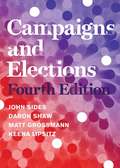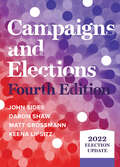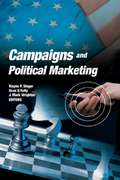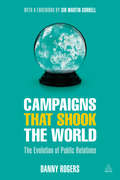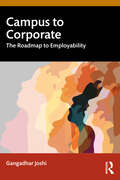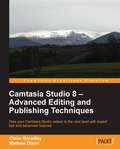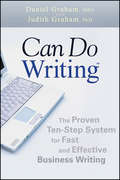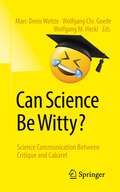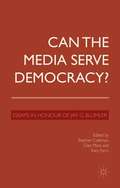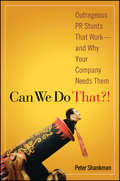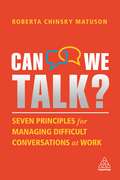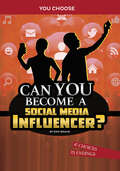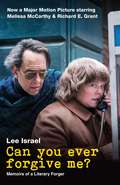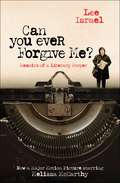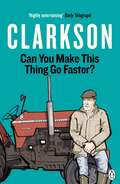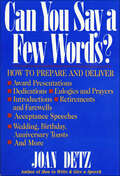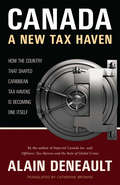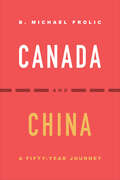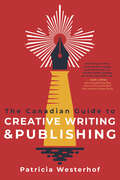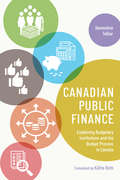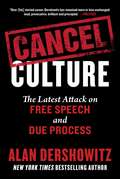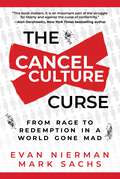- Table View
- List View
Campaign It!: Achieving Success Through Communication
by Alan Barnard Chris ParkerThis ground-breaking book redefines campaigning and explains how to create and deliver a compelling campaign that can be applied in any aspect of your professional and personal life.Based on a claim that is both bold and true, this book introduces and demonstrates a new, unique and complete approach to communication for change - the Campaign It! model. It is a model developed and used by leading professionals in communications and campaigning to create influence and change at the highest levels business, politics and society. It is transferable to any sphere of life. It is tried and tested. And it works.Simply put: to achieve change and be successful you always have to inform, persuade and gain agreement from significant people and organizations. The Campaign It! model enables you to do this powerfully and positively.
Campaigning to the New American Electorate
by Marisa AbrajanoAbrajano (political science, U. of California-San Diego) investigates whether ethnic political campaigns are successful at winning ethnic minority votes, and examines the consequences, if any, that ethnic political campaigns have on the political health and well being of that segment of the ethnic group being targeted. To these ends, she looks at the Spanish-language and English-language televised political advertisements created for the 2000 and 2004 election cycles, and examines their effect on Latino political behavior. Her topics include a theory of information-based advertising, candidates' advertising strategies, advertising effects on the Latino vote, and the future of ethnically targeted campaigns. An epilogue considers the 2008. Annotation ©2010 Book News, Inc. , Portland, OR (booknews. com)
Campaigns and Elections American Style: The Changing Landscape of Political Campaigns
by Candice J. Nelson James A. Thurber David A. DulioWith new and revised chapters throughout, the sixth edition of Campaigns and Elections American Style allows academics and campaign professionals the chance to explain how the COVID-19 pandemic, 2020 general election, and 2022 midterm election upended the campaign process and changed the landscape of political campaigns forever. Offering a unique and careful mix of Democrat and Republican, academic and practitioner, and male and female campaign perspectives, this volume scrutinizes national and local-level campaigns. Students, citizens, candidates, and campaign managers learn not only how to win elections but also why it is imperative to do so in a safe and ethical way. Perfect for a variety of courses in American government, this book is especially valuable to schools of campaign management and campaign professionals working at every level from the local to the global. Highlights of the Sixth Edition Covers the 2020 and 2022 elections with an eye to 2024. Examines changes to the campaign process as a result of COVID-19 and puts them in context with campaign traditions over time. Includes a new organization that moves campaign finance up front to emphasize the centrality of fundraising to successful campaigns. Offers more data to inform campaign planning and management, especially related to key topics such as the change in news media coverage, the growth and use of social media, the use of "big data" in campaigns, and changes in field and voting rules and policies.
Campaigns and Elections (Fourth Edition)
by Matt Grossmann John Sides Keena Lipsitz Daron ShawThe #1 book examines contemporary campaigns and elections—now updated through 2020 Thoroughly revised and updated through the 2020 elections, the Fourth Edition of Campaigns & Elections uses a consistent framework to reveal the strategies and choices that face candidates and other practitioners in the American political system. The authors have set out to help students answer the many questions they have about campaigns while spotlighting contemporary political science research to help them do so. This purchase offers access to the digital ebook only.
Campaigns and Elections (Fourth Election Update Edition): 2022 Election Update
by Matt Grossmann John Sides Keena Lipsitz Daron ShawThe #1 book examines contemporary campaigns and elections—now updated through 2022. Thoroughly revised and updated through the 2022 elections, the Fourth Edition of Campaigns and Elections uses a consistent framework to reveal the strategies and choices that face candidates and other practitioners in the American political system. The authors help students answer the many questions they have about campaigns while spotlighting contemporary political science research in the process. This purchase offers access to the digital ebook only.
Campaigns and Political Marketing
by Sean Kelly Wayne Steger Mark WrightonUnderstand the theoretical-and practical-aspects of political marketing!Over the past few years political marketing strategies have been refined with the help of new findings in political science research. Campaigns and Political Marketing clearly discusses the most recent political science research studies and theories that political activists and professionals can apply to effectively campaign for an issue or candidate. This text is an invaluable compilation of research, theory, and practical application from political science experts across the country that guides readers through the complexities of everyday political marketing and campaigning. Readers get the critical knowledge needed on how to best affect public viewpoints and gain the strongest advantage over the opposition.Campaigns and Political Marketing is packed with information and insights every political activist will find useful. It coherently explains the real world of campaign politics and elections, presenting the everyday issues that political consultants face in the field, all made easily understandable even to the novice. This scholarly examination provides lessons that can be effectively applied to just about any situation. Political crises and scandals are discussed in detail, with research and historical studies that illuminate practical ways to deal with any problem. The book is extensively referenced and uses graphs and charts to clearly explain research findings.Campaigns and Political Marketing answers these tough questions: What is the role of professional campaign consultants-and their value? How have the past four presidential elections revised the state presidential vote forecasting equation? How does interest groups&’ resource distribution differ from resource allocation decisions made by candidates&’ organizations and the national political parties? How does congressional campaign candidate scheduling differ from legislative candidate scheduling? How effective are attack messages in generating media coverage early in a campaign? How do political professionals define campaign crises? What are the differences in public reaction when a candidate from one or the other of the two major parties is in a scandal? How is public opinion affected when tragedy strikes a political candidate?Campaigns and Political Marketing is stimulating, idea-generating reading that is perfect for educators and students in marketing, communications, and political science; practitioners in campaigns and marketing; and political activists of all types.
Campaigns that Shook the World
by Danny RogersOver the past four decades, a series of PR campaigns have helped to shape popular culture and influence public opinion. Campaigns that Shook the World provides the inside story on the pivotal PR campaigns of the past four decades, following and celebrating the maturation and expansion of the PR industry towards today's practice. It examines ten of these campaigns in detail from the 1970s to the present day, explaining their strategy and tactics, looking at the imagery and icons they created and interviewing the powerful, flamboyant personalities who crafted and executed these seminal projects. Each chapter is built around extended case studies including Thatcherism (1979), New Labour, The Royal Family, The Rolling Stones (1981), David Beckham, London 2012, Product [RED], The Obama Campaign (2008) and Dove Real Beauty. Featuring campaigns by Saatchi & Saatchi, Bell Pottinger, Ogilvy, Freuds, Pitch and other well-known agencies, Campaigns that Shook the World grapples with PR's uneasy place at the nexus of politics and celebrity, holding the best campaigns up to scrutiny and showcasing just how powerful PR can be as an instrument of change, for the good, and at times for the less than good. It contains insights from Alastair Campbell, Lord Tim Bell, Alan Edwards, Paddy Harverson, Matthew Freud and many others.
Campus to Corporate: The Roadmap to Employability
by Gangadhar JoshiThis book offers a fresh perspective on the techniques of coping with the challenges of transitioning from student life to a professional corporate environment. It presents an integrated approach and a workable plan for students to pursue and add value to their careers by developing life and business skills that could be seamlessly woven into a well-rounded personality.This book has been designed to help students stand out in terms of knowledge, skills and attitude. It delineates the transition needs (from classrooms to workplace) with clearly defined end results, imparting skills required to excel individually and as part of a team, as a matter of regular practise while working in the corporate world.The primary aim of this book is not just to place graduates in the corporate world but also to enhance their employability skills to make them globally employable in diverse disciplines. Replete with easy-to-use tips and tools with real-world applications, this book will be of immense value to final year graduates and post-graduate students, as well as placement officers of higher education institutions looking to achieve a good placement record.
Camtasia Studio 8: Advanced Editing and Publishing Techniques
by Claire Broadley Mathew DixonA practical guide packed with examples that will show you how to implement the different features of Camtasia Studio 8 and create professional looking projects.If you are familiar with Camtasia Studio and you want to experiment with more advanced techniques, then this is the guide you have been looking for!
Can Do Writing: The Proven Ten-Step System for Fast and Effective Business Writing
by Daniel Graham Judith GrahamA simple, ten-step system for mastering the art of effective, persuasive business or technical writing "The Grahams' system is the best way to transform data and ideas into meaningful information necessary to make profitable decisions. Their system works every time." —Steven Laposa, PhD, MBA, Loveland Commercial Endowed Chair in Real Estate, Colorado State University "The Grahams' straightforward program helps my teams create clear and concise reports, letters, and other documents with minimal effort. I want this program to become the standard for my teams." —Bill Walter, Senior Vice President, Government and Infrastructure Division, KBR "The Can Do Writing system made my career! I used it to write a winning business plan and proposal, and now I use it every day for all communications. Can Do Writing provides valuable insights into business and management as well as writing techniques." —Christian Robey, President, DC Progress You may be an expert at what you do, but if you can't communicate effectively in writing it may not matter. For scientists, businesspeople, and professionals in fields from engineering to public relations, the art of writing well can be a vital key to professional success. Luckily, you don't need an English degree to produce top-class writing. If you're one of the millions of people who have to write clear, persuasive, understandable documents for your job, Can Do Writing is for you. Whether you're writing a business plan, a scientific paper, a press release, or anything else, this simple, straightforward guide will show you how to do it quickly, with style and confidence. You'll learn how to: Understand your audience and subject matter Develop a simple, five-part purpose statement to keep you on track Organize your main points into a coherent, sensible order Edit your work for clarity, coherence, organization, and logic Economize your words to craft a concise, powerful document Make your documents easily readable for any audience
Can Science Be Witty?: Science Communication Between Critique and Cabaret
by Marc-Denis Weitze Wolfgang Chr. Goede Wolfgang M. Heckl"Can science be funny?" takes a close look at an element of modern science communication that is as innovative as it is promising for the future: comedy!Readers are guided through vividly presented academic theory as well as exciting hands-on and best practice examples from renowned practitioners and cabaret artists:- What do sheep's cheese and car tires have in common?- Can laughter break down walls?- How does "Die Anstalt" work?- How does magic create knowledge?- Is there humor in museums?- When a Dalmatian comes to the cash register- Three steps to humor- Serving suggestion for the Holy Spirit- dictatorship of stupidity- And much more!But it's not all just funny. Comedy can also take away some of the biting sharpness of criticism, making it digestible, even palatable, for the addressees."Can Science Be Funny?" navigates between criticism and cabaret, tackling comedy in various guises from different perspectives.22 contributions show how the results of science, research and technology can be brought to the general public in new ways. In particular, they also demonstrate how humour can be used as a critical and questioning force - valuable for all types of communication and helpful so that they come across more shrewdly in the future.
Can the Media Serve Democracy?
by Stephen Coleman Giles Moss Katy ParryThis landmark collection brings leading scholars in the field of political communication to debate one of the most important questions of our age: Can the media serve democracy? For the media to be democratic, they must enter into a positive relationship with their readers, viewers and listeners as citizens rather than consumers who buy things, audiences who gaze upon spectacles or isolated egos, obsessed with themselves. The media's first task is to remind people that they are inhabitants of a world in which they can make a difference. By enabling citizens to encounter and make sense of events, relationships and cultures of which they have no direct experience, the media constitute a public arena in which members of the public come together as more than passing strangers.
Can We Do That!
by Peter ShankmanThis fun and friendly book looks at real-life PR stunts that will blow your mind and inspire you to develop innovative and creative ways to get your company noticed. PR guru Peter Shankman chronicles the most ridiculous, outrageous, and possibly crazy PR stunts of all time-explaining why some work and others don't. This is a funny, insightful guide to winning the PR game.
Can We Talk?: Seven Principles for Managing Difficult Conversations at Work
by Roberta Chinsky MatusonAre you avoiding an uncomfortable conversation at work? If you're an executive or a team leader, strengthening your organization's ability to have difficult conversations is necessary and worth the discomfort.The key to successful dialogue starts and ends with changing the conversation. Recognizing that it takes two people to engage in meaningful outcomes, Can We Talk? outlines what each contributor needs to do to achieve the best possible result. Using examples from everyday work situations, this book offers guidance on how to create the right conditions for a meaningful discussion. The author identifies the seven key principles that enable both parties to gain a deeper understanding of what the other person may be thinking and will help establish their point of view more clearly: confidence, clarity, compassion, curiosity, compromise, credibility, courage.Can We Talk? includes examples and advice from those who have been there and thrived, as well as lessons learned from conversation failures and example scripts of productive conversations. Readers will learn how to prepare, start and manage the potentially challenging exchange of words that typically occur at work, and come away with an understanding that for any conversation to take place, both parties must be engaged.
Can You Become a Social Media Influencer?: An Interactive Adventure (You Choose: Chasing Fame and Fortune)
by Eric BraunDo you want to make social media your microphone to the world? Maybe you're a trend-setter or a social justice leader. Now is your chance to set out a path to social media domination. Face real-life choices that will help you learn about marketing, messaging, and what it takes to make it as a social media star.
Can You Ever Forgive Me?: Memoirs of a Literary Forger
by Lee IsraelNow a major motion picture starring Melissa McCarthy—Lee Israel’s hilarious and shocking memoir of the astonishing caper she carried on for almost two years when she forged and sold more than three hundred letters by such literary notables as Dorothy Parker, Edna Ferber, Noel Coward, and many others.Before turning to her life of crime—running a one-woman forgery business out of a phone booth in a Greenwich Village bar and even dodging the FBI—Lee Israel had a legitimate career as an author of biographies. Her first book on Tallulah Bankhead was a New York Times bestseller, and her second, on the late journalist and reporter Dorothy Kilgallen, made a splash in the headlines. But by 1990, almost broke and desperate to hang onto her Upper West Side studio, Lee made a bold and irreversible career change: inspired by a letter she’d received once from Katharine Hepburn, and armed with her considerable skills as a researcher and celebrity biographer, she began to forge letters in the voices of literary greats. Between 1990 and 1991, she wrote more than three hundred letters in the voices of, among others, Dorothy Parker, Louise Brooks, Edna Ferber, Lillian Hellman, and Noel Coward—and sold the forgeries to memorabilia and autograph dealers. “Lee Israel is deft, funny, and eminently entertaining…[in her] gentle parable about the modern culture of fame, about those who worship it, those who strive for it, and those who trade in its relics” (The Associated Press). Exquisitely written, with reproductions of her marvelous forgeries, Can You Ever Forgive Me? is “a slender, sordid, and pretty damned fabulous book about her misadventures” (The New York Times Book Review).
Can You Ever Forgive Me?: Memoirs of a Literary Forger
by Lee IsraelBefore turning to the criminal life, running a onewoman forgery scam out of an Upper West Side studio shared with her tortoiseshell cat, and dodging the FBI, Lee Israel enjoyed a celebrated reputation as an author. When her writing career suddenly took a turn for the worse, she conceived of the astonishing literary scheme that fooled even many of the experts. Forging hundreds of letters from such collectible luminaries as Dorothy Parker, Noël Coward, and Lillian Hellman -- and recreating their autographs with a flourish -- Israel sold her "memorabilia" to dealers across the country, producing a collection of pitch-perfect imitations virtually indistinguishable from the voices of their real-life counterparts. Exquisitely written, with reproductions of her marvelous forgeries, Can You Ever Forgive Me? is Israel's delightful, hilarious memoir of a brilliant and audacious literary crime caper.
Can You Make This Thing Go Faster?
by Jeremy ClarksonThe hilarious new collection of stories and observations from Jeremy Clarkson - setting our off-kilter world to rights with thigh-slapping wit once again.Who is that tractor-driving Gentleman Farmer?Has Jeremy turned into a horny-handed son of the soil?These and other perplexing questions may or may not be answered in the latest volume of Clarkson's utterly unbiased musings on life, the universe and everything in between (except cars - this isn't one of his four-wheel drive books).Inside you'll also discover why:· Bathing in crude oil isn't for everyone· People who go fishing hate their kids· Noise-cancelling headphones will never silence James May· The rambler who stole his marrow is in for itFull of fact-checked opinions and ideas so good they're no longer following the science but chasing it up a tree, Can You Make This Thing Go Faster? is one hundred per cent guaranteed Clarkson . . .Praise for Clarkson:'Brilliant . . . laugh-out-loud' Daily Telegraph'Outrageously funny . . . will have you in stitches' Time Out'Very funny . . . I cracked up laughing on the tube' Evening Standard
Can You Say a Few Words?: How To Prepare And Deliver A Speech For Any Special Occasion
by Joan Detz-Your alma mater asks you to say a few words at an upcoming fundraising dinner-You've won an employee award and will have to give a short acceptance speech at the ceremony-Your parents are celebrating their 50th anniversary, and you'd like to make a toast at their partyEveryone's counting on you to sound polished, to be prepared, to speak with savvy-in short, to give a speech that's as memorable as the occasion itself.Don't dread these invitations to speak. Instead, learn to prepare clear, concise, and engaging speeches that will live up to your audience's expectations and match the mood of the occasion.Award-winning corporate speechwriter Joan Detz offers solid advice for tackling this nerve-racking task-with pointers, tips, and trade secrets that will help you make the most of every speaking opportunity.Clearly written and fun to read, this invaluable guide provides all the practical advice and encouragement you need to deliver a winning speech.
Canada: A New Tax Haven
by Alain Deneault Catherine BrowneIn Canada: A New Tax Haven, Alain Deneault traces Canada's relationship with Commonwealth Caribbean nations back through the last half of the twentieth century, arguing that the involvement of Canadian financiers in establishing and maintaining Caribbean tax havens has predisposed Canada to become a tax haven itself - a metamorphosis well under way.Canada was linked to Caribbean nations long before they became tax havens. In the 1950s, an ex-governor of Canada's central bank attempted to establish a low taxation regime in Jamaica. In the 1960s, the transformation of the Bahamas into a tax haven characterized by impenetrable banking secrecy was shaped by a minister of finance who sat on the Royal Bank of Canada's board of directors. A Calgary lawyer and former Conservative Party heavyweight drew up the clauses that transformed the Cayman Islands into an opaque offshore jurisdiction. For years, Canadian politicians have debated annexing tax havens such as the Turks and Caicos Islands, making them part of Canadian territory. Canada has signed a free-trade agreement with Panama and is currently seeking a wider agreement with countries in CARICOM, the Caribbean economic community. And, notably, Canada currently shares its seat at the World Bank and the International Monetary Fund with a group of Caribbean tax havens.These exercises in fostering fiscal and banking leniency have predisposed Canada to become one of the most attractive tax havens to foreign interests. Not only does Canada offer one of the lowest corporate tax rates in the world, but a number of loopholes encourage companies to relocate to Canada as if it were Barbados or Bermuda.Canada: A New Tax Haven is an attempt to analyze the situation and address its implications for Canadians.
Canada and China: A Fifty-Year Journey
by B. Michael FrolicPresenting a thorough record of Canada’s diplomatic ties with China, Canada and China recounts ten stories regarding China policy decisions made by the Canadian government. These decisions describe key bilateral moves, beginning with Pierre Trudeau’s recognition of China in 1970 and ending fifty years later with his son Justin’s attempt to reset a struggling relationship with China. Rooted in archival research, extensive interviews, and the author’s experience as a policy observer, the book contributes to our understanding of how the Canada-China relationship has developed over time and how best to position Canada in future relations with China. While present-day relations with China are complicated, the book deliberately seeks to provide a balanced perspective by showing both the positive and the more challenging aspects of relations with China. Ultimately, Canada and China recommends ways to manage future relations with China, while also honouring the ties it developed over fifty years.
The Canadian Guide to Creative Writing and Publishing
by Patricia WesterhofThe essential guide for Canadian writers seeking to have their work published today.How do you get your writing published in Canada? What are the industry standards for publishable work and how do you reach them? This lively, practical guide shows you how to think more creatively, cultivate a strong writing voice, and make your sentences powerful. It explains the elements of style and offers writing prompts to help you apply what you learn. It gives strategies for finding critique partners and beta readers and for getting useful feedback before you send your drafts to agents or editors. The chapters are packed with up-to-date information about the publishing industry, including how to find an agent, how to submit manuscripts to literary journals, how to query independent presses, and how to apply for writing grants. The Canadian Guide to Creative Writing & Publishing confidently leads you through the process of polishing your writing and finding an audience for your work.
Canadian Public Finance: Explaining Budgetary Institutions and the Budget Process in Canada
by Genevieve TellierBroken down into five sections explaining how public budgets are developed, Canadian Public Finance presents a comprehensive account of the budget process of the federal, provincial, and territorial governments. With a specific focus on the public policy process, Geneviève Tellier walks readers through the five steps involved in the budget process including agenda-setting, formulation, adoption, implementation, and evaluation. Taking a close look at how much influence key decision-makers actually have over the budget process, Tellier highlights recent events that reveal the political, social, and economic constraints that impact budgetary decisions. Tellier uses key words and textboxes at the end of each chapter to reflect on current issues and new developments in the world of public finance, such as gender-sensitive budgets, performance-based budgeting, and fiscal transparency.
Cancel Culture: The Latest Attack on Free Speech and Due Process
by Alan DershowitzIn Cancel Culture, Alan Dershowitz—New York Times bestselling author and one of America&’s most respected legal scholars—makes an argument for free speech, due process, and restraint against the often overeager impulse to completely cancel individuals and institutions at the ever-changing whims of social media-driven crowds. Alan Dershowitz has been called &“one of the most prominent and consistent defenders of civil liberties in America&” by Politico and &“the nation&’s most peripatetic civil liberties lawyer and one of its most distinguished defenders of individual rights&” by Newsweek. Yet he has come under intense criticism for his steadfast and consistent championing of those same principles, and his famed &“shoe‑on‑the‑other‑foot test,&” to those who have been &“cancelled&” for any number of faults, both real and imagined. Cancel Culture is a defense of due process, free speech, and even-handedness in the application of judgment. It makes the case for restraint and care in decisions about whom and what to cancel, boycott, deplatform, and bar from public life, and offers recommendations for when, why, and to what degree these steps may be appropriate, as long as objective, fair-minded criteria can be determined and met. While Dershowitz argues against the worst excesses of cancel culture—the rush to judgment and the devastating results it can have on those who may be innocent, the power of social media to effect punishment without a thorough examination of evidence, the idea that historical events can be viewed through the same lens as actions in the present day—he also acknowledges that its defenders ostensibly try to use it to create meaningful, positive change, and notes that cancelling may itself be a constitutionally protected form of free speech. In the end, Cancel Culture represents an icon in the defense of free speech and due process reckoning with the greatest challenge and threat to these rights since the rise of McCarthyism. It is essential reading for anyone interested in or concerned about cancel culture, its effects on our society, and its significance in a greater historical and political context.
The Cancel Culture Curse: From Rage to Redemption in a World Gone Mad
by Evan Nierman Mark SachsIn a groundbreaking first, cancel culture and its core elements are clearly defined, and a convincing case is made against this fundamentally un-American practice. Cancel culture is an insidious force in society today. In the seconds it takes to make one regrettable social media post—or wind up on the wrong side of a false accusation or misunderstanding—reputations, relationships, and careers are destroyed. Have we entered an era when people cannot make mistakes; where no apology or change of heart can ever deliver forgiveness? Making a comeback used to be a celebrated American ideal. But have the roads to redemption been permanently blocked by internet mobs seeking vengeance? In The Cancel Culture Curse, global crisis manager Evan Nierman and his colleague Mark Sachs examine the impact of cancel culture in today&’s media-driven world. The authors also explore the history of cancel culture and the trends that have fostered it, defining the telltale elements that are hallmarks of such campaigns. Nierman and Sachs provide fascinating case studies and interviews with well-known victims of cancel culture, including philosopher Peter Boghossian, Mumford & Sons cofounder Winston Marshall, and &“San Francisco Karen,&” among others. Also featured, is a playbook for rebounding from public shame, helping readers avoid becoming the latest targets of &“cancel vultures&” who enjoy picking apart the remains of those left to die on the side of the Internet highway.
